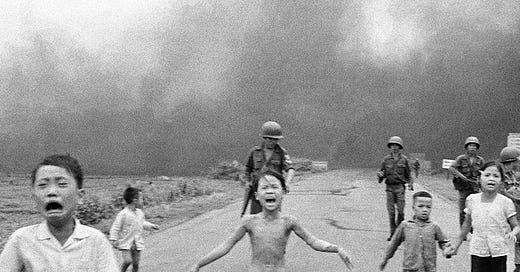“Panic about slave rebellion was common among white people throughout the antebellum South. Although organized rebellions were rare, occasional real examples such as Nat Turner’s slave rebellion added to the apprehension that lead [sic] to panics over imagined rebellions.” (Wikipedia.)
Nat Turner’s slave rebellion occurred in 1831 in Virginia (the old Virginia—West Virginia was not created until 1863). Nat Turner was the leader of the rebellion and the slaves were enslaved African Americans, who killed about 60 white people. Here’s what Israeli philosopher Norman Finkelstein said about it:
The Nat Turner rebellion was replete with the most horrifying atrocities … they killed about 60 people. The order given by Nat Turner was to kill all whites, and they proceeded to do just that.
So, when I read that, a light went off in my head—now I had something roughly analogous to October 7th. Now my next challenge was how to render a judgment on the Nat Turner Rebellion. I went to the people who were closest to me in my political trajectory: the abolitionists. They were very against slavery but very against the use of violence. So, how did they assess the Nat Turner Rebellion?
I turned to William Lloyd Garrison, who was one of the most famous abolitionists—he edited a newspaper called The Liberator. He began by saying, “We told you so.” (He was speaking to white people.) “We told you: if you keep treating people this way, there’s going to be a reaction.” He went on to say that, of course, atrocities—he called them horrors—occurred during the Nat Turner Rebellion, but he never condemned Nat Turner. It was for me an epiphanal [sic] moment.”
(Edited for conciseness from Norman Finkelstein’s interview with Lex Fridman, May 2024.)
What William Lloyd Garrison said about the 1831 Slave Rebellion, and what Norman Finkelstein has said about the October 7 Hamas attacks on Israel fall within what one might label a justified reaction to provocation. The most extreme examples of this legal doctrine come where one partner in a relationship (often a female) takes revenge on the other partner in an incident that per se does not constitute a direct response to provocation, but that comes after a long litany of provocation, denigration, abuse, violence, etc. In such cases, an act of homicide can be classed as self-defence even though, in the moment in which it is perpetrated, the victim (of the homicide) is at calm. The rationale includes the notion that it is only when the victim of the homicide is at calm that the victim of the provocation can strike without fear to herself (or himself).
The actor Charles Bronson acquired a name for himself as a cool, calm, collected vigilante in the series of Death Wish films, but vigilante (and the fantasised version, superhero) is a genre that includes many top flight movies that retain their popularity because the justice system that is meant to protect fails a character in the film, who then sets out to wreak justice for themselves, and this inculcates the sympathies of the audience. The audience roots for the character who takes the law into their own hands.
The defences of self-defence, stand your ground, provocation, reasonable force (for police officers), all shrouded in varying degrees of proportionality, accord the victim of an unconscionable act the justification—if you wish, the right—to take revenge against its perpetrator.
Who we actually root for is in some measure dependent on how the film director navigates the plot. In some, we feel for the vigilante; in some others, we feel for the victims: we protest to the screen, “But he didn’t do anything!”
Leaving aside, then, for the moment, the question of what the many thousands of dead Gazans did to deserve the retribution that has led to their deaths and maimings and hunger and injuries, I turn now to today’s musical excursion, which is a voyage into a mælstrøm of retribution.
Let us look for a second at one of the most famous photographs to emerge from the Vietnam War:1
The girl in the centre is Phan Thị Kim Phúc OOnt; the picture is entitled The Terror of War, and was taken at Trảng Bàng during the Vietnam War on 8 June 1972 by a 21-year-old Vietnamese-American photographer named Nick Ut. She is nine years old in the picture and has just become the victim of a napalm attack.
Napalm is an incendiary mixture of a gelling agent and a volatile petrochemical (usually petrol or diesel). The name is a portmanteau of naphthenic acid and palmitic acid. It rains fire on its victims.
So, how bad does the provocation need to be before you would condone raining fire down on somebody? When I first heard this number, I thought it was a good tune, and even started to sing along with it (I was complimented on my singing voice at work on Friday, by the way).
We have an idea of the kinds of provocation that move the singer in this song, but not the details, so we must trust Adele. What is moving about the lyric is not the horror of what she wants to do to her erstwhile lover, but our extrapolation from the sheer violence of the reaction to how disgustingly she must have been treated to want this horrible revenge.
And that is frightening: we side with Adele because we like Adele, even though we have no details with which to judge her revenge. Her redemption is her readiness to condemn herself as much as she condemns her partner. How rare that is.
Set Fire To The Rain
Written by Adele Adkins and Fraser T. Smith.
Performed by Adele.
From her 2011 album 21.
By Nick Ut, Associated Press - "1973 Photo Contest, World Press Photo of the Year". Originally published in 1972. Cropped from source image to the portion that was published in newspapers in 1972. (backup source http://web.archive.org/web/20110121082648/culturevisuelle.org/catastrophes/files/2010/11/petite-fille-napalm-vietnam.jpg), PD-US, https://en.wikipedia.org/w/index.php?curid=63720060.





